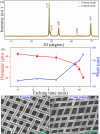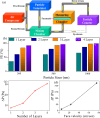Self-Sanitization in a Silk Nanofibrous Network for Biodegradable PM0.3 Filters with In Situ Joule Heating
- PMID: 38434843
- PMCID: PMC10905722
- DOI: 10.1021/acsomega.3c08020
Self-Sanitization in a Silk Nanofibrous Network for Biodegradable PM0.3 Filters with In Situ Joule Heating
Abstract
In the contemporary way of life, face masks are crucial in managing disease transmission and battling air pollution. However, two key challenges, self-sanitization and biodegradation of face masks, need immediate attention, prompting the development of innovative solutions for the future. In this study, we present a novel approach that combines controlled acid hydrolysis and mechanical chopping to synthesize a silk nanofibrous network (SNN) seamlessly integrated with a wearable stainless steel mesh, resulting in the fabrication of self-sanitizable face masks. The distinct architecture of face masks showcases remarkable filtration efficiencies of 91.4, 95.4, and 98.3% for PM0.3, PM0.5, and PM1.0, respectively, while maintaining a comfortable level of breathability (ΔP = 92 Pa). Additionally, the face mask shows that a remarkable thermal resistance of 472 °C cm2 W-1 generates heat spontaneously at low voltage, deactivating Escherichia coli bacteria on the SNN, enabling self-sanitization. The SNN exhibited complete disintegration within the environment in just 10 days, highlighting the remarkable biodegradability of the face mask. The unique advantage of self-sanitization and biodegradation in a face mask filter is simultaneously achieved for the first time, which will open avenues to accomplish environmentally benign next-generation face masks.
© 2024 The Authors. Published by American Chemical Society.
Conflict of interest statement
The authors declare no competing financial interest.
Figures






Similar articles
-
Radiative Thermal Management in Face Masks with a Micro/Nanofibrous Filter.Nano Lett. 2024 Apr 17;24(15):4462-4470. doi: 10.1021/acs.nanolett.4c00308. Epub 2024 Apr 4. Nano Lett. 2024. PMID: 38574275
-
Review on need for designing sustainable and biodegradable face masks: Opportunities for nanofibrous cellulosic filters.Int J Biol Macromol. 2024 Dec;283(Pt 2):137627. doi: 10.1016/j.ijbiomac.2024.137627. Epub 2024 Nov 14. Int J Biol Macromol. 2024. PMID: 39547626 Review.
-
P(VDF-TrFE)/BaTiO3 Nanofibrous Membrane with Enhanced Piezoelectricity for High PM0.3 Filtration and Reusable Face Masks.ACS Appl Mater Interfaces. 2023 Feb 1;15(4):5845-5855. doi: 10.1021/acsami.2c19569. Epub 2023 Jan 18. ACS Appl Mater Interfaces. 2023. PMID: 36652453
-
Cost-Effective Face Mask Filter Based on Hybrid Composite Nanofibrous Layers with High Filtration Efficiency.Langmuir. 2021 Jun 22;37(24):7492-7502. doi: 10.1021/acs.langmuir.1c00926. Epub 2021 Jun 8. Langmuir. 2021. PMID: 34101479
-
Protective Face Masks: Current Status and Future Trends.ACS Appl Mater Interfaces. 2021 Dec 8;13(48):56725-56751. doi: 10.1021/acsami.1c12227. Epub 2021 Nov 19. ACS Appl Mater Interfaces. 2021. PMID: 34797624 Review.
References
-
- Sahoo M.; Sethi N. The Dynamic Impact of Urbanization, Structural Transformation, and Technological Innovation on Ecological Footprint and PM2.5: Evidence from Newly Industrialized Countries. Environ. Dev. Sustain. 2022, 24, 4244–4277. 10.1007/s10668-021-01614-7. - DOI
-
- Wang S.; Gao S.; Li S.; Feng K. Strategizing the Relation between Urbanization and Air Pollution: Empirical Evidence from Global Countries. J. Clean. Prod. 2020, 243, 118615.10.1016/j.jclepro.2019.118615. - DOI
LinkOut - more resources
Full Text Sources
